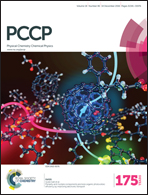The mechanism of an enzymatic reaction-induced SERS transformation for the study of enzyme–molecule interfacial interactions†
Abstract
We report the observation of a novel effect in which the vibrational frequencies and spectral intensity of enzyme (E)-conjugated surface-enhanced Raman scattering (SERS)-active reporter molecules (4-mercaptobenzoic acid (4-MBA)) shift and change regularly as a function of the concentration of the substrate molecule (S). We attribute the frequency shifts and intensity changes in the E-reporter complex to the binding of S to the active site of E, which affects the electronic structure, polarizability and electron density of the molecule. Our observations demonstrate the creation of an E-conjugated SERS-active reporter complex as a SERS-active nano-mechanical sensor for bio-detection. Specifically, we used glucose oxidase (GOx), which was capable of achieving detection sensitivity comparable to that of a conventional sandwich enzymatic reaction. Furthermore, 2D correlation SERS spectroscopy was performed to better investigate the glucose-responsive mechanism, and the results of these experiments support our proposed conclusion. These findings pave a new pathway for utilizing the specific response to glucose via the SERS method, which can achieve a detection limit of 10−6 mol L−1 for glucose and cover a much wider concentration range, including the blood glucose concentrations in healthy (3–8 mmol L−1) and diabetic (9–40 mmol L−1) individuals, than the current chromogenic assays.



 Please wait while we load your content...
Please wait while we load your content...